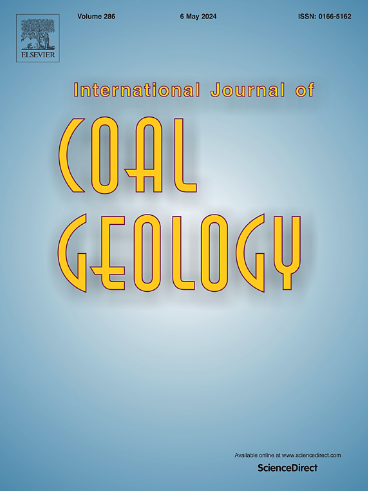中国西南地区储集层固体沥青与中低温热液矿物的关联:来自有机岩石学和硫同位素的启示
IF 5.7
2区 工程技术
Q2 ENERGY & FUELS
引用次数: 0
摘要
西南地区固体沥青常与金属矿床共存,表明有机质与成矿具有成因联系。然而,这种联系仍未得到充分探讨。本文利用金属硫化物的硫同位素研究了硫的成因与有机质成熟度的关系。有机岩石学表明,与矿物伴生的固体沥青具有较强的光学各向异性(ΔBRo > 3.32%)和较高的S/C原子比(0.029 ~ 0.033),高于非伴生沥青(0.005 ~ 0.021)。流体包裹体分析表明,矿期方解石包裹体均一温度高于古油藏,表明成矿作用加速了油气热演化。固体沥青-矿物组合可分为密西西比河谷型、层状汞型和浸染型金矿床。硫同位素组成确定了三种硫源:细菌硫酸盐还原(BSR)、热化学硫酸盐还原(TSR)和含硫有机质热分解(TDS)。兰坪-思茅盆地δ34SCDT值低于0‰,表明硫来源于BSR,烃类为还原硫。雪峰山脉隆起带δ34SCDT值超过20‰,表明tsr驱动硫,成矿作用增强了油气聚集和成矿作用。在康店轴,δ34SCDT值在20‰以下,表明硫来自TSR和TDS,成矿作用导致原油裂解和储层破坏。研究结果表明,成矿作用加速了有机质成熟,重塑了储层,推动了原油裂解。同时,有机-无机相互作用控制着金属硫化物的形成和沉淀,强调了它们在成矿中的关键作用。本文章由计算机程序翻译,如有差异,请以英文原文为准。
Implications of solid bitumen association with low- to medium-temperature hydrothermal minerals in hydrocarbon reservoirs of Southwest China: Insights from organic petrology and sulfur isotopes
Solid bitumen in Southwest China often coexists with metal deposits, indicating a genetic link between organic matter and ore formation. However, this linkage remains underexplored. This study investigated the relationship between sulfur origin and organic matter maturity through sulfur isotopes of metal sulfides. Organic petrology revealed that solid bitumen associated with minerals exhibited stronger optical anisotropy (ΔBRo >3.32 %) and higher S/C atomic ratios (0.029–0.033) than non-associated bitumen (0.005–0.021). Fluid inclusion analysis showed that ore-stage calcite inclusions have higher homogenization temperatures than those in paleo-oil reservoirs, indicating that ore-forming processes accelerated hydrocarbon thermal evolution. Solid bitumen-mineral associations were classified into Mississippi Valley-type (MVT), stratiform mercury, and disseminated gold deposits. Sulfur isotope compositions identified three sulfur sources: bacterial sulfate reduction (BSR), thermochemical sulfate reduction (TSR), and thermal decomposition of sulfur-containing organic matter (TDS). In the Lanping-Simao Basin, δ34SCDT values below 0 ‰ suggest sulfur derived from BSR, with hydrocarbons contributing reduced sulfur. In the Xuefeng Mountains Uplift, δ34SCDT values exceeding 20 ‰ indicate TSR-driven sulfur, with metallogeny enhancing hydrocarbon accumulation and mineralization. In the Kangdian Axis, δ34SCDT values under 20 ‰ suggest sulfur from TSR and TDS, with mineralization causing oil cracking and reservoir destruction. The findings demonstrate that metallogeny accelerates organic matter maturation, reshapes reservoirs, and drives oil cracking. Simultaneously, organic-inorganic interactions govern metal sulfide formation and precipitation, underscoring their critical role in ore genesis.
求助全文
通过发布文献求助,成功后即可免费获取论文全文。
去求助
来源期刊

International Journal of Coal Geology
工程技术-地球科学综合
CiteScore
11.00
自引率
14.30%
发文量
145
审稿时长
38 days
期刊介绍:
The International Journal of Coal Geology deals with fundamental and applied aspects of the geology and petrology of coal, oil/gas source rocks and shale gas resources. The journal aims to advance the exploration, exploitation and utilization of these resources, and to stimulate environmental awareness as well as advancement of engineering for effective resource management.
 求助内容:
求助内容: 应助结果提醒方式:
应助结果提醒方式:


